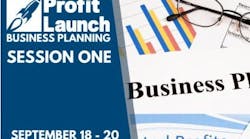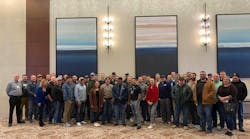CLEVELAND, OHIO — Contractors employ the most employable people in the world, James Leichter said, because service technicians can quit and get a job in a day and a bad service tech can get a job in two days. Techs can quit for another 50 cents an hour, he noted, but paying performance pay allows them to take control over their compensation while making more money for the contracting business owner.
Leichter addressed contractors at the Contractor Leadership Live conference and show here in mid-September. Leichter started his career as an HVAC service tech. He is one of the founding faculty members of the Electric & Gas Industry Association, owns software firm Aptora Corp., mrhvac.com, and blackbeltcontracting.com. He has a lot of accounting and financial expertise but considers himself, at heart, to be an HVAC guy.
Leichter’s talk covered the federal legalities of wages, pay options for technicians, installers, office folks and salespeople, and how to set up a profit sharing program.
Wages are covered by the Fair Labor Standards Act of 1938, Leichter said, and it is still a comparatively short and simple law that has not changed much over the years. Minimum wage must be paid for the first 40 hours in a week, time and half for any overtime. A week is considered to be seven contiguous days. Overtime cannot be “banked.” It has to be paid in the week it was earned. Base pay (on which overtime is calculated) must include everything, including commissions, spiffs, even a gift card or holiday turkey. Consequently, a tech could have a base pay of $25/hour one week and $42/hour the next.
FLSA requires that time in and out must be tracked but doesn’t specify how. Time clocks are recommended and Leichter noted that mobile time clock apps that work off of GPS are a good alternative.
If a technician is in your truck, he or she must be paid. A key phrase, Leichter noted, is “under your control and influence.” If they are, then they are working. If your technician stops to pick up a helper along the way, once the helper is in the truck, he is under your control and influence and must be paid.
Implementation can be a challenge, and you might have to give your service techs a raise to get them to buy in.
Leichter pointed out that he was no fan of the IRS: “I don’t like it, but it’s all very fair.”
Contractors should not offer the standard X-dollars per hour with a review after 90 days. If you find yourself a home runner hitter, performance pay gives him the opportunity to make a lot more money right away. Too often techs get themselves into financial troubles and ask for a raise. Performance pay allows the contracting business owner to point out how they can work their way out of it by selling, for example, more indoor air quality packages or service agreements. A good program will reward the winners but not antagonize the mediocre employees who are inevitable in any organization.\
Straight time actually penalizes fast workers and provides no incentives for slow workers to improve. A slow worker has no financial incentive to buy better or more expensive tools, because if he needs to, it’s an opportunity to go to the local wholesaler, eat popcorn, look at the want-ads on the bulletin board and talk to his buddies.
Performance pay is based on the billable labor hours for service so a skilled worker who hustles can work eight hours and get paid for 10.
Implementation can be a challenge, and you might have to give your service techs a raise to get them to buy in. The object is to get labor costs set at a predictable level, such as 40 percent of labor dollars. Techs are paid the book time; if your book says the job should take two hours, they get paid for two hours regardless. Pay one hour for travel and diagnosis. If travel is problematic, pay them extra based on zones or map codes.
If you charge more, they get paid more. If you charge a premium for evening hours or if you’re charging overtime rates, the tech should be paid the overtime rate, even if he hasn’t worked 40 hours yet. At the same time, the tech has to own callbacks for 30 days. If there’s a callback, deduct the labor hours from his pay for the original repair. He’s still making way, way more than minimum wage anyway.
Your commission list must be explainable to the world. Pretend the local news is going to show up, Leichter said, and you have to explain your pay rates to them. If it’s explainable and your service techs are satisfied, you’re good.
Office staff must be eligible for bonuses. Leichter has a three page list of actions at mrhvac.com that result in bonuses for office staff, such as customer referrals or referrals of new employees.
The installation department should be paid off a set list of labor hours. Write up as many installation scenarios as you can, Leichter advised, and the crews are paid for those hours. He admitted that some installations might be so unusual that you will essentially have to revert to time and materials for those exceptions.
Sales people should be paid straight commission, as long as there is enough opportunity for them to sell and make a decent living. Leichter recommended paying the salesperson 20 percent of gross, so if a $10,000 job has a 50% gross profit, the salesperson would get $1,000 commission. You’ll have to work out other details such as paying a flat rate for sick days and holidays or whether you want to supply a vehicle and a cell phone or compensate them for using their own.
You can create a profit sharing plan based on sales goals and gross profit goals. Say, for example, that your quarterly goal is $300,000 in sales and 46 percent gross profit, and if they hit that goal they get paid a bonus of 20 cents for every hour worked in the quarter. Create a table showing how much employees will be paid for even higher sales, higher gross profit and combinations of both. If you have an extremely successful quarter, you might pay them a bonus of, for example, 90 cents for every hour worked.









